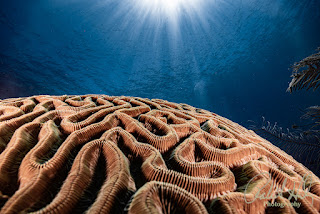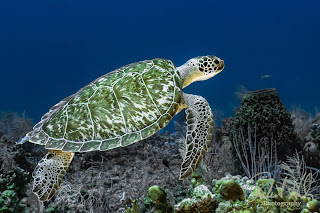Quick Edits for Underwater Travel Photos Using Lightroom Mobile
The Adobe Lightroom package includes Lightroom Classic (LrC) and Lightroom (Lr). Both of these products are powerful yet simple to use on laptops, deskside, or mobile devices, and they can share photos via the cloud. Lr is designed to work best on mobile devices and uses the Cloud for storage and data exchange with the LrC product, but both offer the same editing capabilities.
Capturing stunning underwater scenes is just half the adventure on a dive trip. The other half is refining those photos to bring out the vibrant beauty of the underwater world. But what if you're traveling light or don’t have access to your full editing setup? That's where Lightroom Mobile comes in, offering a powerful suite of tools at your fingertips.
This comprehensive guide explores advanced yet easy-to-follow techniques for quickly enhancing your underwater travel photos using Lightroom Mobile. From correcting color casts to reducing backscatter using AI, I’ll walk you through how to make your images pop—all while you're still on the go!
1. Start with Auto Settings: The First Step in Your Editing Journey
Before making detailed adjustments, apply Lightroom Mobile's Auto settings to your photo. This feature uses Adobe Sensei AI technology to analyze the image and adjust exposure, contrast, highlights, shadows, and more.
How to Do It:
- Once your photo is imported, tap the Auto button under the Light panel.
- Review the changes to see if they provide a good baseline. From here, you can make further refinements.
Tip: Auto settings often miss the mark with underwater images due to the unusual lighting conditions, but it’s a great place to start. Think of it as a digital assistant that sets the stage for your fine-tuning work.
2. Tackle Color Casts with White Balance Adjustments
Underwater photography is notorious for color imbalances. Due to light absorption, photos often appear washed out in blues and greens, with reds and yellows heavily muted. Correcting the white balance is one of the most crucial steps to restore your image’s natural vibrancy.
How to Do It:
- Go to the Color panel and use the Temperature slider to add warmth (yellow) and reduce cool tones (blue).
- Adjust the Tint slider to correct green or magenta shifts.
- For more precision, tap on the Eyedropper Tool and select a neutral gray area in your image (e.g., a piece of white coral or the reflective surface of a dive tank).
Advanced Tip: Lightroom Mobile’s Color Mix and Color Grading panels give you even more control. Try isolating specific color ranges, like enhancing the reds of fish scales or the yellow hues of coral, to make these elements stand out against the background.
3. Enhance Details Using Texture, Clarity, and Dehaze
Capturing underwater subjects like marine life or delicate coral structures can often produce soft, low-contrast images. The Texture, Clarity, and Dehaze sliders can help bring out details without compromising the natural look of your image.
How to Do It:
- Increase Clarity to boost mid-tone contrast and define the edges of your subject.
- Use the Texture slider to highlight details like scales, fish patterns, or coral textures.
- Apply Dehaze to reduce the underwater haze caused by suspended particles, but be careful—too much can introduce noise.
Tip: Avoid maxing out these sliders. Overuse can make your photos look overly sharp and artificial, especially when viewed on larger screens.
4. Use AI-Powered Tools for Backscatter Removal
Backscatter—those pesky white spots caused by flash reflections off particles in the water—is the bane of underwater photographers. Lightroom Mobile’s Healing Brush has evolved with AI capabilities that make backscatter removal much more efficient.
How to Do It:
- Select the Healing tool and choose Spot Healing.
- Zoom in on areas with backscatter and tap to remove each spot. Lightroom's AI will analyze the surrounding pixels and replace the spots with a natural blend.
- For clustered backscatter, switch to the Clone tool for more precision.
AI Enhancement Tip: Lightroom’s latest updates have introduced AI Masking tools that can detect and differentiate subjects from the background. Use the Select Subject mask to isolate your main subject, and then apply a subtle blur to the background. This not only reduces backscatter visibility but also creates a beautiful depth-of-field effect.
5. Fine-tune colors with the HSL and Color Grading Panels
Once you've corrected the overall color balance, it’s time to breathe life into your underwater photos using the Hue, Saturation, and Luminance (HSL) panel.
How to Do It:
- Increase the Saturation of colors like red, orange, and yellow to restore their natural vibrancy.
- Lower the Luminance of blue and green hues to deepen the background and make your subject pop.
- Experiment with the Color Grading panel to independently adjust the colors in the shadows, mid-tones, and highlights. For example, add a bit of teal to the shadows and warm up the highlights for a balanced look.
Tip: If your subject has a distinct color (like a bright red lionfish), use the Targeted Adjustment Tool to isolate and enhance only that color. This will make your subject more prominent without affecting the rest of the image.
6. Create Stunning Depth with AI-Powered Masking and Blur Effects
One of the most exciting new features in Lightroom Mobile is its AI-powered Masking tools. By automatically detecting and isolating your main subject, you can create edits that emphasize your subject while reducing distractions in the background.
How to Do It:
- Tap the Masking icon and select Select Subject.
- Apply a small amount of Clarity and Sharpening to the subject mask to enhance details.
- Invert the mask (choose everything except the subject) and apply a subtle Blur effect to the background using the Noise Reduction slider.
This workflow effectively blurs out the background, reducing backscatter and focusing attention on your main subject. It creates a beautiful bokeh effect even underwater.
7. Refine Your Composition with Cropping and Transform Tools
After enhancing the details and colors, ensure your photo’s composition is on point. Lightroom Mobile’s Crop and Transform tools let you straighten horizons, correct perspective distortions, and remove unwanted elements from the frame.
How to Do It:
- Use the Crop tool to straighten your image, especially if you have a tilted horizon line.
- Apply the Transform tool if the subject appears distorted due to a wide-angle lens or unusual shooting angle.
Tip: For social media posts, use pre-defined aspect ratios, like 4:5 for Instagram or 16:9 for landscapes, to ensure your photos look great on all platforms.
8. Save Your Favorite Adjustments as Custom Presets
If you find a combination of settings that works well for your underwater photos, save it as a preset! This will save you a ton of time, especially when batch editing multiple shots from the same dive site.
How to Do It:
- Tap the three dots at the top of the screen and select Create Preset.
- Choose which settings to include, such as white balance, clarity, and HSL adjustments.
- Name your preset and use it as a one-tap solution for future edits.
With Lightroom Mobile, you don’t have to wait until you’re back at your desktop to bring your underwater photos to life. By leveraging its AI-powered tools and intuitive sliders, you can quickly and effectively transform your raw captures into vibrant images that truly capture the beauty of your dive adventures. Whether removing backscatter, enhancing colors, or refining your composition, Lightroom Mobile ensures you can share polished photos with your followers—no matter where your travels take you!
Happy editing, and may your underwater adventures always be filled with breathtaking photos! 🌊📸
Stay Connected
Follow my blog for more tips and tutorials on underwater photography. Let's dive deeper into the art and craft of capturing the marine world!
Subscribe to my blog for more tips and tutorials on underwater photography. Remember to share your processed photos on social media using the hashtag #RobertHerbPhotography. I look forward to reviewing your results.
New Online Training Program
I am excited to announce that I am creating an online training program to teach underwater hobbyists and enthusiasts how to enhance their photos using Adobe Lightroom. If you are interested in this training or need more information, please go to (Underwater Photo Training) or contact me at bob@robertherb.com to express your interest and to be notified about the details and start date of the classes.
Stay tuned and "Follow" for upcoming blogs on underwater photography tips and tricks for more in-depth insights. Please leave your comments and suggestions. Enjoy your diving and shooting experience!
I am eagerly anticipating your valuable feedback and suggestions.
Sincerely,
Bob Herb
|
|





Comments
Post a Comment
Please let me know your comments.